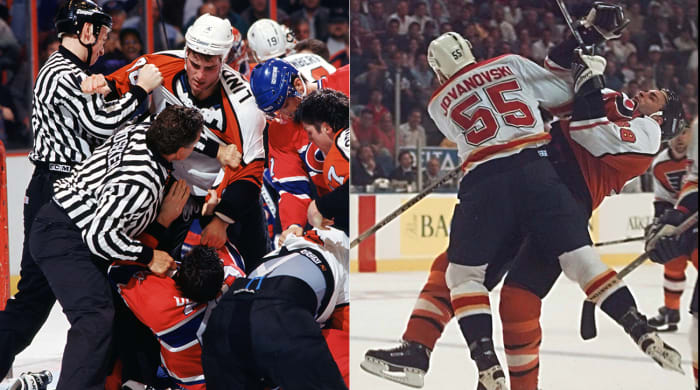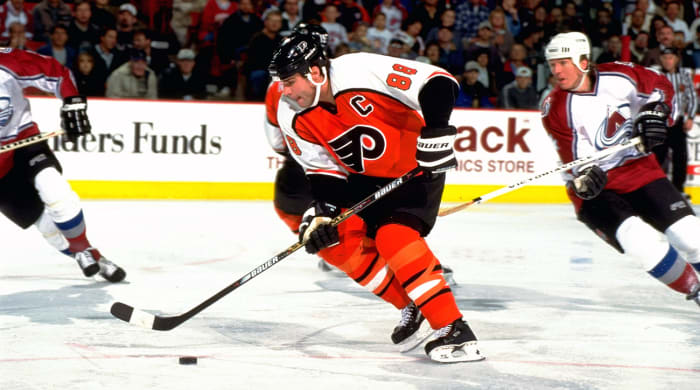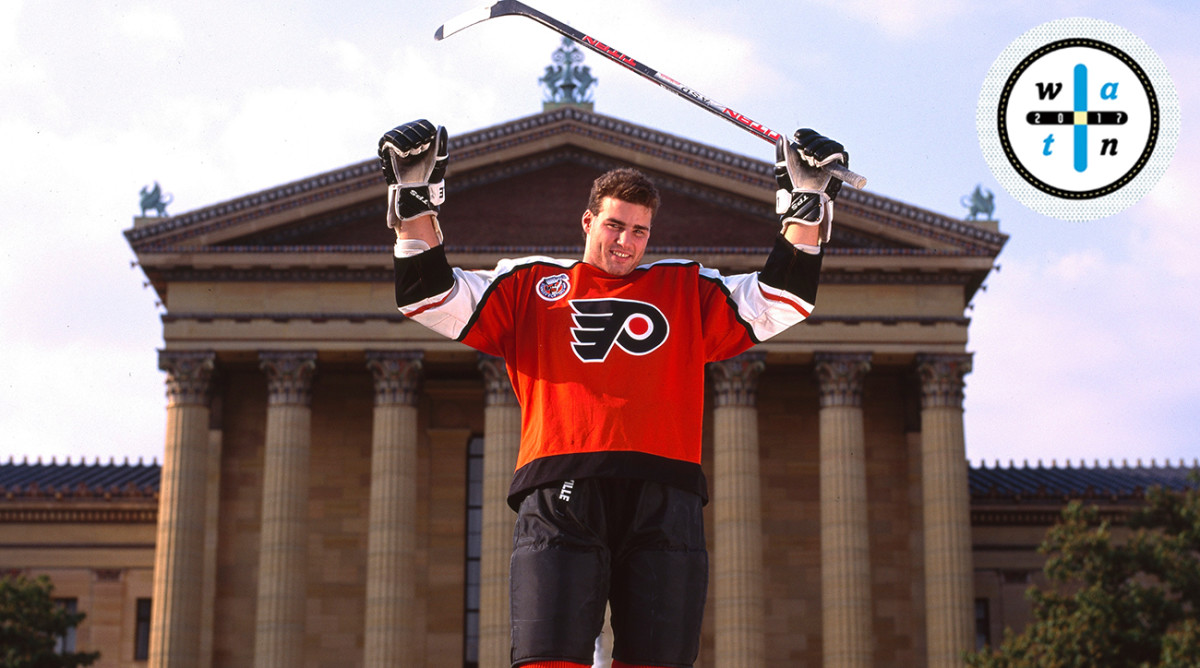Eric Lindros is worried about everyone's concussions but his own
Brains are unselfish; they rarely think about themselves. They worry about the hand that might get burned on the stove, or the heart that needs to keep beating, or maybe even the mole on the leg that is probably nothing but should probably be looked at by a professional. Brains send alerts to favor the sore back and tell feet to walk gingerly on hot pavement. But brains generally assume they themselves will be fine.
You see this in pro sports all the time. There are stories of athletes intentionally tanking their baseline concussion tests, so that if they get hit in the head, their foggy test results wouldn’t look so bad, and they won’t be ordered to sit. When the NHL decided, in the late 1970s, that players should wear helmets, some players got so mad that they had to reach a compromise: Players who signed contracts before the ’79–80 season didn’t have to wear one. Seventeen years later Craig MacTavish was still playing NHL games without a lid.
Eric Lindros’s brain is different. It knows better. It worries. Not about itself, so much—after a 15-year NHL career that was slowed and finally stopped by concussions, Lindros, 44, says he is doing just fine. He worries about other brains: in kids on the playground, in car accident victims, in athletes at all levels.
“We can do better,” he says again and again, and this is not an idle complaint from his kitchen table. It is a mission of his postplaying life. Lindros, who retired in 2007, envisions “having the ability to sit there and get a pinprick when you’re on the bench and saying, ‘Should I go or not?’ . . . Wouldn’t that be nice? They’re getting there, but it needs funding.”
In sports today, the word concussion is often followed by the word lawsuit. But lawsuits cover the past. Lindros wants everybody to focus on the future. Like he has.
• Read all of Sports Illustrated’s best Where Are They Now? stories
A lifetime ago, Eric Lindros skated his final NHL shift, for the Dallas Stars. If fans could barely recognize him, that was understandable; he could hardly recognize himself.
Lindros had started his career as the most hyped prospect in NHL history. He ended it as a role player in Dallas. As he took the ice for Game 7 of a first-round series against the Canucks, he had conflicting thoughts: He wanted the season to keep going, but he also wanted his career to end.
“I couldn’t believe it came to that,” he says. “I knew it was my last game. I wasn’t having fun.” The Stars lost 4–1.
In the 1990s every sport seemed to produce a new breed of athlete. Basketball had Shaquille O’Neal. Golf had Tiger Woods. Baseball had Ken Griffey Jr. Hockey had Lindros. At his peak, the 6' 4", 240-pound Lindros, with his hands, speed and size, was one of the most imposing forces in the game’s history. “I don’t think people realize just how dominant he was,” says his Flyers linemate John LeClair. “He took over games—and not just once in a while. It was almost every night, usually from start to finish.”
The Lindros arsenal may not have been as lethal as Wayne Gretzky’s, but it was more physically intimidating. He could shoot, stickhandle and set up teammates, and if you weren’t looking, he would hit you so hard, you would feel as if you’d just been run over by a Zamboni. He knew it. Opponents knew it. And Lindros knew they knew it. Says LeClair, “He was in guys’ heads before the puck even dropped.”
Lindros could sense it after one or two shifts: That guy wants no part of me. Guys would be scared to go into the corner. They’d skate as if they didn’t want to wake a baby.
The Philadelphia line of Lindros, LeClair and right wing Mikael Renberg was known as the Legion of Doom, and if that sounds hyperbolic, you didn’t skate against them. Through the 1998–99 season Lindros had averaged 1.39 points per game—which would have ranked fourth in NHL history. He was +177 in 431 career games. (By comparison, Pittsburgh’s Sidney Crosby, the finest all-around player of this generation, is +165 in 782 career games.)
How Allen Iverson finally found his way home
In 1999, Gretzky retired, and Lindros, just 26, seemed poised to take over the league. But he had already suffered at least one concussion, on a devastating hit by Penguins defenseman Darius Kasparaitis in ’98. The Flyers, like most pro sports teams, knew so little about concussions that they sent him to a migraine specialist. His ’98–99 season had ended shortly after the team was slow to diagnose a collapsed lung after a road game. (Lindros nearly died.) The following year was marked by three concussions and public disputes between his parents and Flyers general manager Bobby Clarke, notably on matters regarding Lindros’s health. “When Eric was getting concussions, they were like, ‘Give him a couple of days, and he’ll be fine,’ ” LeClair says. Late in that season, a year after the collapsed lung, the Flyers stripped him of his captaincy.
At times, he looked like the old Eric Lindros, but he often felt like a shell of his former self. And it wasn’t just on the ice. It was the same when he was driving, or in crowds, or saw bright lights, or heard loud noises. He was concussed. We all know the symptoms now, but we didn’t all know them then. “You just feel off,” he says. “You might look like you can do it, you’re quite capable and everything. You’re off. You’re moody, you’re tired.”
He whispers something unprintable to describe how he felt. We’ll go with cranky. “Cranky, sure,” he says. “There is no point in going backwards. This is not a p.r. battle.”
Lindros missed the first 16 games of the Flyers’ 2000 postseason, and when he returned during the Eastern Conference finals, Devils star defenseman Scott Stevens leveled him with a shoulder to the head in Game 7. Lindros went down hard.
Stevens had exploited one of Lindros’s few flaws: He sometimes skated with his head down, leaving him vulnerable to massive hits he didn’t see coming. After the collision with Stevens, Lindros was never the same player again, and it was his last game as a Flyer.
Lindros bounced from Philly to the Rangers to the Maple Leafs to the Stars, hoping to salvage his career with a Stanley Cup. By the time he got to Dallas, Lindros had become the kind of player he used to intimidate. He worried. He avoided contact. He found himself looking up at the clock during practice, thinking, When did we start? I can’t wait for this to be over.
Reminded that the Stevens hit was legal at the time, Lindros says, “Was it?”
Are you saying it wasn’t?
“I’m not saying anything. It happened. It is what it is,” he says. “Let’s move on. Let’s do something better.”
Lindros is standing in his kitchen in Toronto, watching the three children he has with his wife, Kina—three-year-old Carl and 20-month-old twins Ryan and Sophie—play in the adjoining living room. Carl picks up a soft plastic orange-and-black stick and ball. Wounds, both literal and physical, have healed. Lindros is not angry or bitter. He says he talks regularly with Flyers president Paul Holmgren. Clarke publicly supported Lindros’s Hall of Fame case. (He was inducted in 2016.) He wants the Flyers to do well.
He feels like Eric Lindros again, but he would rather talk about Rowan Stringer. The 17-year-old from Ottawa was so determined to play rugby that she played through two concussions in a week. She died on May 12, 2013, four days after sustaining the second one. The coroner published 49 recommendations to improve education and communication about head injuries. There was a push to make all the recommendations law in Ontario. Stringer’s father, Gordon, says the proposed legislation had stalled last year until Lindros stepped in. Rowan’s Law passed in June ’16.
“He could be a simmering pool of unhappiness,” Stringer says. “But he came out and said, ‘This is something we’ve got to do.’ I think that resonated with a lot of people.”
These days, Lindros plays rec hockey with some buddies: No checking, no worries. He thinks that most hockey should be played this way. If you’re not a pro, or on your way to the pros, why are you checking? “Let’s not focus on ‘What a great hit!’ ” Lindros says. “Let’s say, ‘What a great pass.’ ”
A generation ago it was hard to fathom Lindros, the once powerful force, preaching against hitting. But he knows, better than most, the folly of mistaking size for invincibility. He remembers 6' 5" peers Jeff Beukeboom and Keith Primeau also retiring because of concussions.
Away from the NFL spotlight, financial ruin drove Clinton Portis to the brink of murder
Lindros is pushing to make Rowan’s Law the standard for all of Canada. He hopes the U.S. follows suit. He works with See the Line, an organization focused on concussion education, and leading doctors to help raise money for the Concussion Project, a research initiative at Western University in London, Ont. He is determined to improve standards for brain care, with more comprehensive, mandatory training for teachers and coaches, and clearer lines of communication amongst all parties involved in an athlete’s career. Nobody can strip Lindros of his captaincy now.
“Let’s do better,” he says. “We’re not asking the world of people. We’re just asking for solidarity. We’re asking for a common message.”
Lindros doesn’t have to do this work. He could just bounce from one paid appearance to the next, appear on TV a few times a week and never mention the word concussion again. He is not the only Hall of Famer who retired because of concussions. Steve Young did. So did Brett Favre. There is an opening for Lindros to become a marketing phenomenon, to remind the world how great he was. But he does not have that in him. As his brother, Brett, says, “I know a lot of guys, as soon as you get a couple of beers in them, all they want to do is talk about themselves. Glory days. I think Eric is more focused on the future than the past.”
Lindros is working on Rowan’s Law because he thinks he can help. The truth is, he doesn’t even really enjoy the work—at least not in the way that you might enjoy playing golf. When you are the public face of a movement, people expect you to use your mouth. Lindros always brings cue cards.
“I detest public speaking,” he says, “but when forced to do it, I can do it.”

Lindros gave out just as much punishment as he took, which led to no small amount of schadenfreude when concussions cratered his career.
Bruce Bennett Studios/Getty Images;Hans Deryk/AP
People want to know how many concussions Lindros suffered in his career, as if there’s a category for that on his hockey-reference.com page alongside his 372 career goals and 493 assists. He says, “I could guess, but what’s the point? [Anyway], it’s not about numbers. It’s about severity and how they affect individuals differently.”
Brett, the ninth pick in the 1994 draft, retired because of concussions at age 20, after 51 career games with the Islanders. Eric says he had “no idea” his brother’s issues were that severe until Brett retired.
Two years later Eric’s slide began. And this is undeniable: A lot of people enjoyed watching his decline. Lindros had been a controversial figure since before he played his first NHL shift. In 1991 he refused to play for the Nordiques after they drafted him No. 1; ultimately, he sat for a year and forced a trade to the Flyers. He says he didn’t want to play for Quebec owner Marcel Aubut.
But at the time, Lindros’s father, Carl, expressed concerns about playing in a province that was threatening to secede. There were accusations of elitism and claims that Eric hated French-Canadians, and the controversy came to define him as much as his talent did. When Lindros was just 18, he told reporters, “I believe everyone was put on Earth for a purpose. Mine was to sell newspapers.” The Quebec humor magazine Croc depicted Lindros as a Ku Klux Klansman with the billing ERIC LINDROS FINALLY FINDS HIS TEAM. When he returned to Quebec with the Flyers, a radio station passed out 3,000 pacifiers. People pelted the ice with eggs, batteries and bullets. Bullets.
Even if Lindros hates revisiting the past, history has vindicated him in some ways. Aubut’s reputation was later destroyed—he was forced to resign as president of the Canadian Olympic Committee in 2015 after he was accused of sexual harassment. And the Nordiques moved to Denver in 1995.
Today’s fans have a better understanding that players have rights, that owners are no more likely to care about the fans than players are and that you can cheer manically for your local sports-team business, but it is still a business. In 2004 the San Diego Chargers drafted Eli Manning No. 1 overall, but he Lindros’ed: He didn’t have faith in the organization, so he demanded a trade and got one. You rarely hear that used against him. In ’05 the Penguins drafted Crosby No. 1 overall; Crosby has missed months at a time because of concussions, but reasonable people do not question his desire to play. If anything, you hear people worry that Crosby comes back too fast.

Lindros's tendency to skate with his head down put him in peril when the NHL's most feared enforcers squared him up.
Robert Beck
“Did you get a nice Mason jar to drink from?” Kina cracks to him.
She is standing in the kitchen, mocking her husband’s choice in glassware. Fans who think Eric doesn’t like French-Canadians should know that he married one. Kina has made his postretirement years a lot more fun than they would have otherwise been. Eric, who has a tendency to drift toward pessimism, says, “My wife is a very positive person. She looks at things in a different fashion.” Says LeClair, “The last four or five years, he seems really happy.”
Lindros does not watch many NHL games, but that’s mostly because his son Ryan wakes up before 5 a.m., and by evening Eric is exhausted. He is no longer tortured by what might have been, and so he appreciates what is. He watched Crosby grow from a gifted young player who spent too much time barking at refs to the best player in the world. Concussions are part of the Crosby story, just as they were part of Lindros’s, but it’s a different ending. This makes Lindros happy.
“The guy is a stud,” he says. “And he’s got the respect. It’s easier, you know. It’s like . . . I don’t know how to say it.”
He laughs. He could talk about how attitudes have changed, how most fans understand that Crosby’s health is more important than his ice time and how the Penguins have supported their star in ways that teams did not 20 years ago . . . but what would be the point? Lindros does not want a fight. He wants funding. He wants coaches to communicate with each other and researchers to have breakthroughs. He wants us to take better care of our brains. This is the perspective of a man who has finally learned to look up.


































